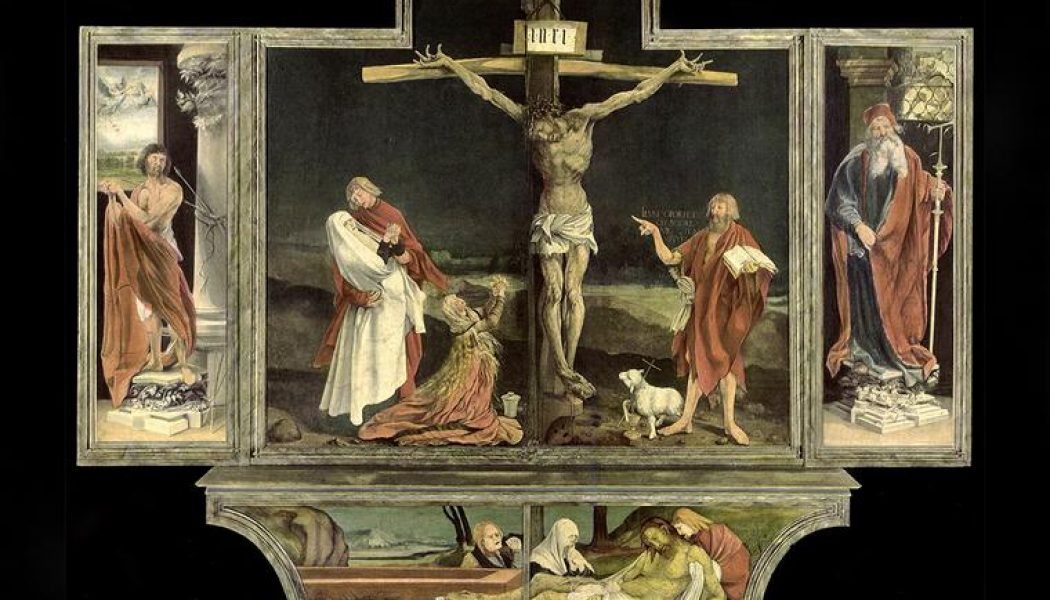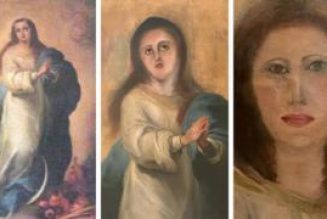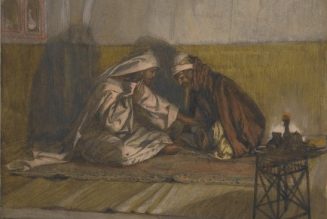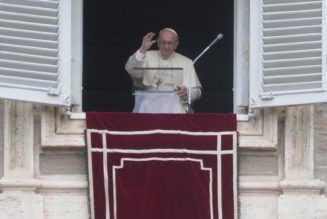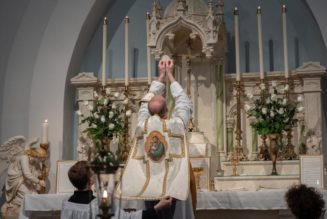
Choosing a work of art to illustrate this Sunday’s readings was harder than usual, because the Fourth, Fifth, and Sixth Sundays of Lent take their Gospels from John and tend to deal with more abstract ideas: the Good Shepherd, the Vine and the Branches, Being Called Jesus’ Friends.
Most artists depicting religious themes tend to have a more historical approach, representing what an event might have looked like. But when we come to the kinds of theological abstractions found in parts of John’s Gospel and which we focus on in the latter weeks of the Easter Season, finding artistic representations becomes more challenging because the art must also be more abstract and symbolic.
One way of getting around the challenge is to focus on one of the other readings. But I’ve tried this year to focus on the Gospel because that lection always has pride of place among the Sunday readings. Granted, a Passion motif seems out of character in Eastertide but, given today’s Gospel, an exception seems warranted. Today’s Gospel (John 15:9-17) is actually part of Jesus’ long discourse at the Last Supper and so in fact is presented in the Gospel as preceding his death.
In today’s Gospel, Jesus speaks about what Christian love entails. The Gospel merits our attention, because an enormous number of sins seem to be committed or at least justified in the name of “love.” The problem is that not everything someone thinks of or titles as “love” is the real McCoy.
Jesus is clear in today’s Gospel: “love” and “keeping my Father’s commandments” go together. We might keep the Commandments for the right reasons (because doing so expresses true love) or the less right ones (out of legalistic or formalistic motives). But that proposition does not mean that “love” can ever be disconnected from God’s Commandments. “Love” is not an abstract label whose content is established ad hoc in the moment. “Love” and God’s Commandments are never opposed. Jesus is clear: if you want to “remain in My Love” you will keep the Commandments. You will not “make it up as you go along.”
Christianity has always been plagued by one or another variant of “antinomianism,” a heresy that downplays or ignores moral law and moral principles in the name of some amorphous and non-descript “you’ll recognize it when you see it” “love” of Christ. St. John already rejected it: “[T]his is love: that we walk in obedience to his commands” (2 John 1:6).
St. Paul faced the same problem in First Corinthians. Corinth was a port city, with all the morals typical of a port city. When St. Paul began speaking of “freedom from the Law” (by which he meant freedom from relying on the Law as a means to salvation, not freedom from the Law as the moral content salvation requires), the Corinthians first took the idea as “party city!”
When Paul writes to the Corinthians, he notes a “Christian” was “sleeping with his father’s wife” (1 Corinthians 5:1) and apparently had no moral problem with it, because “I have the right to do anything” in the name of “Christian freedom” (6:12). [Besides, it was only a physical thing and, in a Hellenic world tinged with dualism, the significance of the body was minimized, not unlike our own day, when mental states are also deemed capable of cancelling the significance of biological realities].
Paul repudiates these false and confused notions of freedom and love, insisting who he is to judge “those inside the Church” (5:12-13).
This same point — that the content of “love” is spelled out in the Commandments — is reiterated elsewhere in the Johannine literature. “We know we have come to know him if we keep his commands. Whoever says, ‘I know him’ but does not keep his commands is a liar” (1 John 2:3-4). “Everyone who sins breaks the law; in fact, sin is lawlessness” (1 John 3:4).
Today’s Gospel having made clear what love demands and that “you are my friends if you do what I command you” (John 15:14), Jesus lays down the acid test of what friendship (which presupposes Commandment-rooted love) demands: “Greater love than this no man hath than to lay down one’s life for one’s friends” (v. 13).
Which is why — Eastertide notwithstanding — we return to the Passion, specifically as depicted by Matthias Grünewald.
When we lived in Switzerland, the first museum my wife insisted we visit was Unterlinden Museum in Colmar, France, about 90 minutes north of Bern. Colmar is in that disputed piece of geography wedged between France and Germany called Alsace (as in Alsace-Lorraine). Much of the border today is formed by the Rhine River: France to the west, Germany to the east.
Particularly in the 13th-14th centuries, that territory experienced a pronounced spiritual-mystical ferment that found expression in various spiritual authors collectively called the “Rhineland Mystics.” That spiritual ferment continued into the 15th and even 16th centuries, when Grünewald’s Isenheim altarpiece originated. It dates from around 1512-16.
The Grünewald Altar was originally in a nearby monastery, which cared for victims of the Plague and other skin diseases. While what we call the “Black Death” reached its apex in the 14th century, mutations and recurrences of that pandemic persisted around Europe through the 17th century. Grünewald’s Isenheim Altar was a Passion depiction for people who knew they were dying from a pandemic. Our own experience of COVID-19 perhaps helps us for once understand what living in a time of pandemic disease might have felt like.
Jesus’ Passion is vividly depicted there. His body is contorted, his upper torso inflated as one would expect when the center of bodily weight is shifted from one’s rear to one’s chest by being suspended by one’s arms. The body-wide effects of his scourging are apparent. (Roman scourging typically involved bits of bone or metal sewn into the thongs of the whip in order to penetrate and tear skin). The wounded body and distended limbs both emphasize the tortures of crucifixion as well as offered a sign of solidarity to the Plague victims for whom this altarpiece was designed.
The splayed hands are particularly compelling, considering that crucifixion through the wrist (the only anatomically possible way to hang a human on a cross, artistic representations notwithstanding) would sever a nerve controlling the fingers while the weight of the body would induce distension and spasms in the arms. The black background reinforces the theme of death.
Remember, as we noted on “Good Shepherd” Sunday, that depictions of the crucified Jesus appear late in Christian art, after the abolition of crucifixion as a form of capital punishment. Crosses may have appeared, but not with the corpus with the brutal details of what that death penalty wrought.
Grünewald’s Altar graphically and visually drives home Jesus’ remarks in today’s Gospel about giving one’s life “for one’s friends” as the ultimate testament and measure of love.
It prompts two other reflections. When so many today prioritize physical protection protocols over all other considerations, the radical nature of Jesus’ self-giving becomes even starker. The Isenheim Altarpiece does not show us a man who gives his life despite all steps of prudent avoidance to the contrary, but one who gives his life … period.
Second, while the John’s Gospel tells us that giving one’s life is the supreme proof of friendship, Paul reminds us that what the Isenheim Altarpiece depicts is the moment when God and man were precisely not friends. “Now most people would not be willing to die for a righteous person, though for a good person someone might possibly dare to die. God proves his love for us in this, that while we were still sinners, Christ died for us” (Romans 5:7-8).
“While we were still sinners!” Jesus’ sacrifice makes our redemption possible, but does not guarantee it. Despite the grandeur of Jesus’ generous gift, no man will be saved without wanting to make that gift his own. Jesus gave — and still gives — his “friendship” completely, absent any guarantee that anyone will be a taker. The Isenheim Altarpiece shows exactly that.
Master Grünewald returned to similar depictions of Jesus’ Passion, one of which is owned by the National Gallery of Art in Washington (but may not be on view). But, bearing in mind the truth about friendship the Grünewald Altar shows, take a look at the crucifix in your home to understand what today’s Gospel means. (It’s also a good reason — if one’s not already there — to ensure your house has a cross in it).
Join Our Telegram Group : Salvation & Prosperity
